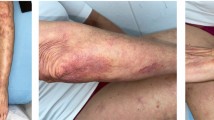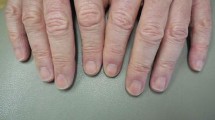Abstract
Background
Langerhans cell histiocytosis previously known as histiocytosis X is a rare disease of children and young adults with a very broad clinical spectrum. In children, its annual incidence is estimated between 0.2–0.5 per 100,000.
Case representation
An 8-year-old Moroccan girl with no known personal or family history presented to our institution with painful swelling of both forearms. An X-ray and magnetic resonance imaging were inconclusive. We then performed a biopsy curettage (of her left forearm). Microscopic analysis followed by immunohistochemical analysis disclosed a diagnosis of Langerhans cell histiocytosis. No chemotherapy was necessary. Clinical and radiological improvement was achieved after 6 months.
Conclusion
The particularity of this observation is the bilaterality of the lesion on both forearms and it has not previously been reported. Langerhans cell histiocytosis should be included in the differential diagnosis of osteomyelitis and Ewing’s sarcoma.
Similar content being viewed by others
Introduction
Langerhans cell histiocytosis (LCH) is a rare disorder characterized by a proliferation of cells causing local or systemic effects [1]. LCH includes the clinical entities of eosinophilic granuloma (EG), Letterer–Siwe disease, and Hand–Schuller–Christian disease [2, 3]. EG is the most common form of LCH, and involves single or multiple bones [3]. The disease is characterized by proliferation of the Langerhans cells that usually causes pain and adjacent soft tissue swelling [4]. It is a relatively uncommon disease suffered by infants and children [5]. The involvement of both forearms is extremely rare and not previously reported to the best of our knowledge; it is this rare form of LCH that we report in this observation.
Case representation
An 8-year-old Moroccan girl presented to our institution with painful swelling of both forearms which initially appeared on her left forearm and 6 months later on her right forearm. Her family history and medical history were unremarkable. Given the exacerbation of the pain she consulted a doctor who obtained plain radiographs and noted a lesion in both forearms. She was then referred to us for further evaluation. She reported that despite daily use of nonsteroidal anti-inflammatory medications and narcotic analgesics, the pain in her forearms continued to progress. On physical examination she had no fever and had a good general condition. She presented a swelling in the upper third of her right forearm and the upper two-thirds of her left forearm with inflammatory signs (Fig. 1). Laboratory studies found a moderate anemia (hemoglobin at 10 g/dL) and a white blood cell count of 11,210/μL with 80% neutrophils. Her C-reactive protein level was 60 mg/L. We obtained plain radiographs (Fig. 2) that showed: an osteolytic lesion of the upper one-third of the right ulna and osteolytic lesion of the upper two-thirds of the left radius. On both forearms, we did not note mineralized matrix production, but a cortical breakthrough and internal trabeculations were present. We therefore performed magnetic resonance imaging (MRI) (Fig. 3) which showed: an osteolytic lesion mass (arrow) of the upper one-third of her right ulna and the upper two-thirds of the left radius. The mass was invading her elbow joint whose matrix was in hyposignal T1 (Fig. 3a), hypersignal T2 (Fig. 3b), and short T1 inversion recovery (STIR) (Fig. 3c), containing septa and enhanced annularly after injection of gadolinium (Fig. 3d). The lesion began in the diaphysis and crossed the physis. A soft tissue mass and cortical breakthrough were noted. A soft tissue edema was also seen. A biopsy curettage of her left forearm was done. A histopathologic examination revealed a proliferation of histiocytes with an infiltration of eosinophils (Fig. 4). These histiocytes were positive for S-100 protein (Fig. 5a) and for CD-1a (Fig. 5b). No chemotherapy was necessary. Our patient’s symptoms disappeared after a short (5 days) period of nonsteroidal anti-inflammatory therapy. A repeat X-ray was obtained (Fig. 6) and showed a partial improvement of the osteolysis. She remained asymptomatic after 6 months.
Magnetic resonance imaging findings. An osteolytic lesion mass of the upper one-third of the right ulna and the upper two-thirds of the left radius. The mass invading the articulation of the elbows whose matrix is in hyposignal T1 (a), hypersignal T2 (b), and short T1 inversion recovery (c), containing septa and enhanced annularly after injection of gadolinium (d)
Discussion
LCH is a rare disease with an incidence of 0.2–0.5 per 100,000 children per year [6]. The disease involves typically patients aged from 5 to 15 years in approximately 90% of cases, with a slight male predominance [6]. To the best of our knowledge, a bilateral localization of LCH on both forearms has not been reported. The most frequent site of EG is the skull followed by the femur, then the ribs. Localization in the forearm is approximately 1.5% [7]. The most common complaint is the pain, often worse at night [8]. However, a fracture, a swelling, a deformity, and a soft tissue component are also encountered. The lesions caused by LCH are often located on the diaphysis, the metaphysis, or extend to the physis and epiphysis of the long bone [9]. Cortical thinning, intracortical tunneling, and medullar widening are often found on radiography. The periosteal reaction, while less common, may be present at an early phase of the disease, giving a more aggressive and pseudomalignant appearance [9]. The most common lesions on MRI are perilesional bone marrow edema, periosteal reaction, endosteal scalloping, and postcontrast enhancement with or without soft tissue mass [10]. The differential diagnoses include aneurysmal bone cyst, osteomyelitis, Ewing’s sarcoma, osteoblastoma, Gaucher’s disease, acute leukemia, and metastatic tumor [11]. The diagnosis of EG is based on histological and histochemical identification. The therapeutic modalities include observation for spontaneous resolution, biopsy, curettage with or without bone grafting, local steroid injection, anti-inflammatory drugs, bisphosphonates, radiotherapy, chemotherapy, and immunotherapy [6]. The results of treatment of solitary lesions are always satisfactory. In contrast, multifocal and multisystem types of LCH are generally treated with chemotherapy in combination with other therapeutic modalities [5].
Conclusion
LCH is a rare disease in children with a very broad clinical spectrum. The particularity of this observation is the bilaterality of the lesion on both forearms and it has not previously been reported to the best of our knowledge. LCH should be included in the differential diagnosis of osteomyelitis and Ewing’s sarcoma.
References
Azouz EM, Saigal G, Rodriguez MM, Podda A. Langerhans’ cell histiocytosis: pathology, imaging and treatment of skeletal involvement. Pediatr Radiol. 2005;35:103–15.
Song YS, Lee IS, Yi JH, Cho KH, Kim DK, Song JW. Radiologic findings of adult pelvis and appendicular skeletal Langerhans cell histiocytosis in nine patients. Skelet Radiol. 2011;40:1421–6.
Oguro K, Sakai H, Arai M, Igarashi T. Eosinophilic granuloma of bone: two case reports. Brain and Development. 2013;35:372–5.
Park TH, Kim J, Oh TY, Park YJ. Solitary Langerhans cell histiocytosis arising from sternum: a case report. J Pediatr Surg. 2012;47:e9–12.
Tsuchie H, Okada K, Nagasawa H, Yano M, Nanjyo H, Shimada Y. Langerhans cell histiocytosis of the sternum. Ups J Med Sci. 2009;114:121–5.
Parikh SN, Desai VR, Gupta A, Anton CG. Langerhans cell histiocytosis of the clavicle in a 13-year-old boy. Case Rep Orthop. 2014;2014:510287.
Howarth DM, Gilchrist GS, Mullan BP, Wiseman GA, Edmonson JH, Schomberg PJ. Langerhans cell histiocytosis: diagnosis, natural history, management, and outcome. Cancer. 1999;85:2278–90.
Kilpatrick SE, Wenger DE, Gilchrist GS, Shives TC, Wollan PC, Unni KK. Langerhans’ cell histiocytosis (histiocytosis X) of bone. A clinicopathologic analysis of 263 pediatric and adult cases. Cancer. 1995;76:2471–84.
Hoover KB, Rosenthal DI, Mankin H. Langerhans cell histiocytosis. Skelet Radiol. 2007;36:95–104.
Hashmi MA, Haque N, Chatterjee A, Guha S. Langerhans cell histiocytosis of long bones: MR imaging and complete follow up study. J Cancer Res Ther. 2012;8:286–8.
Garg B, Sharma V, Eachempati KK, Malhotra R, Bhan S. An unusual presentation of eosinophilic granuloma in an adult: a case report. J Orthop Surg Hong Kong. 2006;14:81–3.
Acknowledgements
The authors thank the patient and her parents for allowing us to publish this case report.
Funding
None.
Availability of data and materials
Data will not be shared in the open access version of the paper. Please contact the corresponding author to receive information on the dataset supporting the conclusions of this article.
Author information
Authors and Affiliations
Contributions
HC, BE, KS, and SI conceived and designed the study, collected data, and data interpretation. KA, LC, and AA revised critically the paper. All authors wrote, read, and approved the final manuscript.
Corresponding author
Ethics declarations
Ethics approval and consent to participate
The study was approved by the ethics committee of University of Sidi Mohamed Ben Abdellah, BP 1893.
Consent for publication
Written informed consent was obtained from the patient’s legal guardian(s) for publication of this case report and accompanying images. A copy of the written consent is available for review by the Editor-in-Chief of this journal.
Competing interests
The authors declare that they have no competing interests.
Publisher’s Note
Springer Nature remains neutral with regard to jurisdictional claims in published maps and institutional affiliations.
Rights and permissions
Open Access This article is distributed under the terms of the Creative Commons Attribution 4.0 International License (http://creativecommons.org/licenses/by/4.0/), which permits unrestricted use, distribution, and reproduction in any medium, provided you give appropriate credit to the original author(s) and the source, provide a link to the Creative Commons license, and indicate if changes were made. The Creative Commons Public Domain Dedication waiver (http://creativecommons.org/publicdomain/zero/1.0/) applies to the data made available in this article, unless otherwise stated.
About this article
Cite this article
Idrissa, S., Cherrabi, H., Efared, B. et al. Langerhans cell histiocytosis presenting as eosinophilic granuloma of the bilateral forearms in an 8-year-old girl: a case report. J Med Case Reports 13, 67 (2019). https://doi.org/10.1186/s13256-019-2011-1
Received:
Accepted:
Published:
DOI: https://doi.org/10.1186/s13256-019-2011-1










